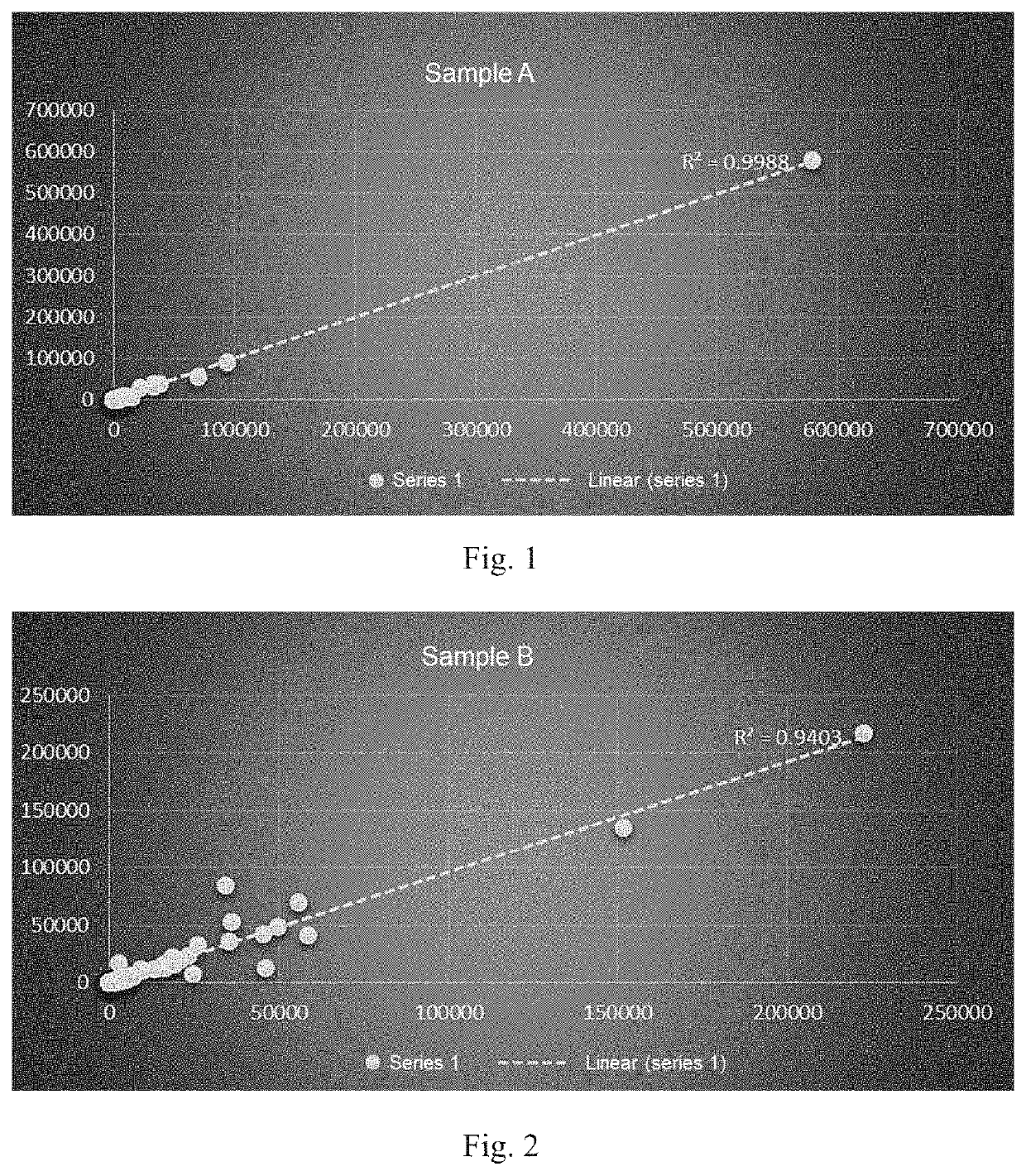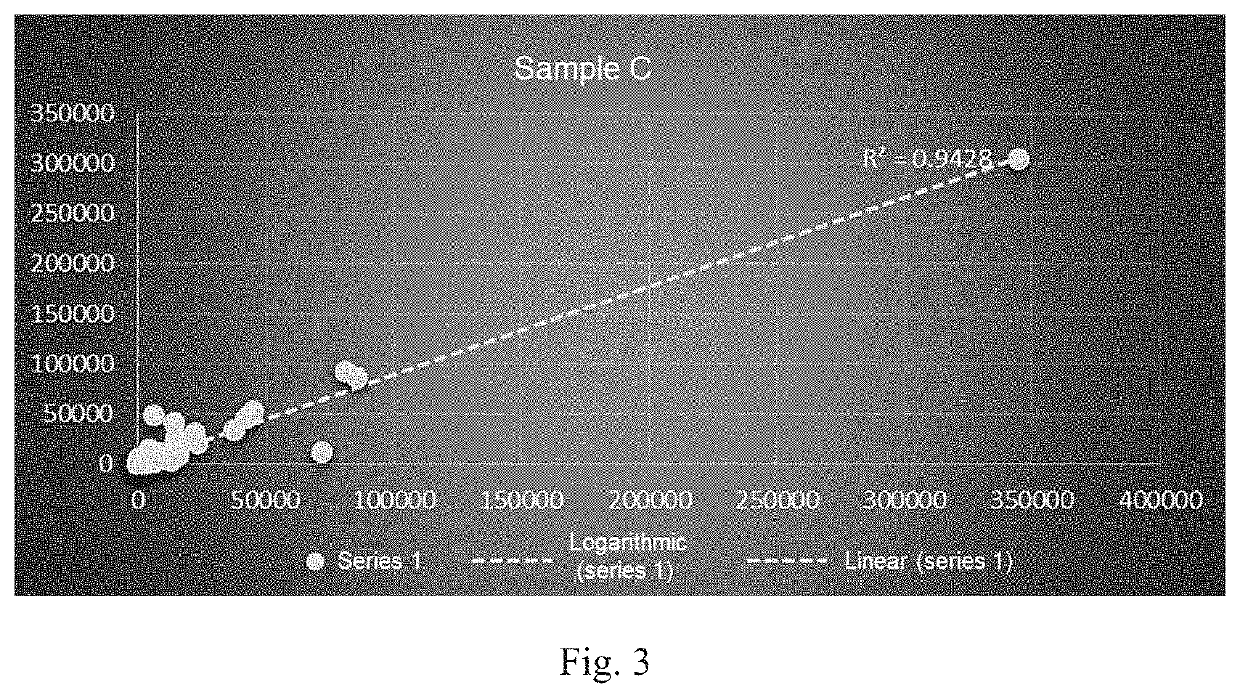Primer composition for analyzing intestinal flora and application thereof
a technology compositions, applied in the field of molecular biology, can solve the problems of large restrictions on the study of gastrointestinal microbial communities by traditional methods involving time- and energy-consuming culture itself, and the inability to obtain destructive gastrointestinal sample collection for wild protected animals, etc., to achieve the effect of reducing the proportion of phix, increasing complexity, and increasing sequencing quality
- Summary
- Abstract
- Description
- Claims
- Application Information
AI Technical Summary
Benefits of technology
Problems solved by technology
Method used
Image
Examples
example 1 preparation
of a Detection Kit
[0071](1) Preparation of a primer composition
[0072]The first forward primer has the nucleic acid sequence as shown in SEQ ID NO. 1, and the first reverse primer has the nucleic acid sequence as shown in SEQ ID NO. 2. The nucleic acid sequences are listed as follows.
The first forward primer (SEQ ID NO. 1):TCGTCGGCAGCGTCAGATGTGTATAAGAGACAGNNTGCCTACGGRRBGCASCAGKVRVGAAT;the first reverse primer (SEQ ID NO. 2):GTCTCGTGGGCTCGGAGATGTGTATAAGAGACAGNNGGGGACTACNVGGGTWTCTAATCC;
[0073]wherein N represents any one of bases A\T\G\C.
[0074]The P5-end adaptor sequence has the nucleic acid sequence as shown in SEQ ID NO. 3-12 which are listed as follows.
SequenceAdaptor nameSEQ ID NO. 3CTCTCTATS502SEQ ID NO. 4TATCCTCTS503SEQ ID NO. 5GTAAGGAGS505SEQ ID NO. 6ACTGCATAS506SEQ ID NO. 7AAGGAGTAS507SEQ ID NO. 8CTAAGCCTS508SEQ ID NO. 9CGTCTAATS510SEQ ID NO. 10TCTCTCCGS511SEQ ID NO. 11TCGACTAGS513SEQ ID NO. 12TTCTAGCTS515
[0075]The P7-end adaptor sequence has the nucleic acid sequence as shown i...
example 2 extraction
of Sample DNA
[0094]Three stool samples A, B and C were selected and divided into 2 equal parts, marked as: A1 / A2, B1 / B2 and C1 / C2. A1, B1 and C1 were processed with the method described herein to obtain data. A2, B2 and C2 were sent directly to GENEWIZ for sequencing. The specific DNA extraction method included the following steps:
[0095](1) 700-800 μl of buffer A and 250 mg of glass beads were added to a 2 ml centrifuge tube;
[0096](2) 250 mg of sample was added to the above 2 ml centrifuge tube and vortexed for 10 s;
[0097](3) 70 μl of lysis buffer B was added to the sample, vortexed for 7 min to mix the sample, and centrifuged at 12,000 rpm (˜13,400×g) for 60 s. The supernatant (500 μl) was transferred to a new 2 ml centrifuge tube;
[0098](4) 250 μl of suspension buffer C was added, vortexed for 10 s, allowed to stand at room temperature for 2 min, and centrifuged at 12,000 rpm (˜13,400×g) for 60 s to precipitate sample particles;
[0099](5) The supernatant was transferred to a new 2 m...
example 3
Library Construction
[0114](1) The reaction solution described below was prepared on ice. Except for H2O and the extracted DNA solution, a premixed amplification Mix was prepared with the following components in an amount of the reaction number+α. The prepared premixed Mix was dispensed into PCR reaction tubes. The reaction system was as follows:
AgentVolume2× PCR Mix (Mg2+, dNTPs)12.5 μlUpstream primer (1 μM)5μlDownstream primer (1 μM)5μlSample DNA 5 ng / μl (or ddH2O)2.5μlTotal25μl
[0115]A negative control group using water as a sample was set up.
[0116]The reaction conditions were as follows:
Reaction Number ofprocedurecyclesAmplification95° C. 3 min1procedure95° C. 30 s2853° C. 30 s72° C. 30 s72° C. 5 min1
[0117](2) Purification of the product of the first round of PCR
[0118]The product of the first round of PCR amplification was purified by using Agencourt AMPure XP (Beckman Coulter Corp.) with the specific steps of:
[0119]1) Agencourt AMPure XP magnetic beads were taken from the 4° C. r...
PUM
| Property | Measurement | Unit |
|---|---|---|
| molar concentration | aaaaa | aaaaa |
| volume fraction | aaaaa | aaaaa |
| volume fraction | aaaaa | aaaaa |
Abstract
Description
Claims
Application Information
 Login to View More
Login to View More - R&D
- Intellectual Property
- Life Sciences
- Materials
- Tech Scout
- Unparalleled Data Quality
- Higher Quality Content
- 60% Fewer Hallucinations
Browse by: Latest US Patents, China's latest patents, Technical Efficacy Thesaurus, Application Domain, Technology Topic, Popular Technical Reports.
© 2025 PatSnap. All rights reserved.Legal|Privacy policy|Modern Slavery Act Transparency Statement|Sitemap|About US| Contact US: help@patsnap.com


